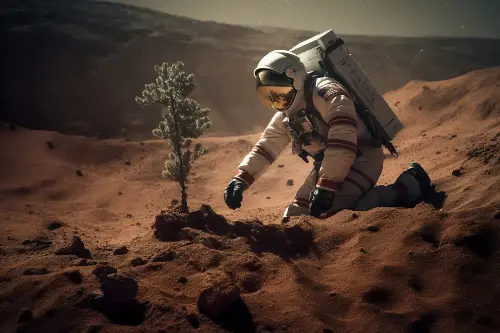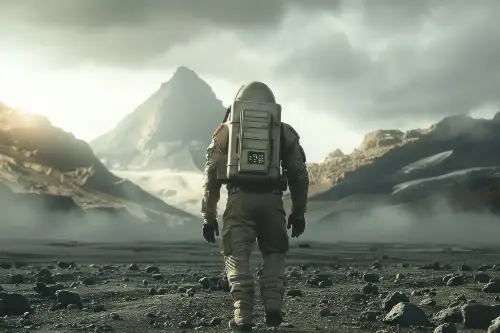Picture a crimson landscape stretched as far as the eye can see, beneath a sky dusted with stars—it’s no longer just a fixture of science fiction but a potential future for humanity. The human race, gifted with unyielding curiosity and resilience, now stands on the cusp of an extraordinary adventure: making alien worlds like Mars habitable for humans. This concept, known as terraforming, presents an array of scientific challenges and ethical considerations that are as vast as space itself.

Understanding Terraforming
The core idea behind terraforming is to transform the environmental conditions of a non-Earth like planet, making it suitable for human life. Mars stands out as the prime candidate for such an endeavour, thanks to its relatively hospitable conditions, proximity, and the presence of essential resources such as water ice. However, before we start packing our spacesuits, we must delve into the complexities of the science behind this cosmic landscaping.
The Martian Makeover
Mars, our neighbour, has been the subject of fascination for generations and potentially the first stop in humanity's journey to becoming a multi-planetary species. However, to convert this barren world into a second Earth, numerous hurdles need to be overcome. The thin Martian atmosphere offers little protection from harmful cosmic radiation, and its low temperatures would make the Sahara feel like a tropical paradise. Overcoming these challenges necessitates advanced science and engineering, and a host of innovative ideas have been proposed.
Building a Breathable Atmosphere
For Mars to support human life, we need an atmosphere rich in oxygen and nitrogen, akin to Earth’s protective shroud. One proposed method to achieve this is to release the greenhouse gases trapped within the Martian surface to warm the planet, a process termed as “global warming on purpose." By nudifying the planet's ample reserves of carbon dioxide, we could initiate a runaway greenhouse effect, gradually raising temperatures to more habitable levels.
Water, Water Everywhere?
Explorers will be quite thirsty upon their arrival, but Mars may cater to this need. The presence of water ice at the poles and beneath its surface could serve as a crucial resource not only for drinking but also for cultivating crops. Moreover, if the planet can be warmed sufficiently, this water could theoretically flow once again, contributing to the formation of a hydrological cycle reminiscent of Earth's, complete with rain and rivers.

Powering the Red Frontier
For a permanent human settlement to thrive on Mars, it will need an unfaltering supply of power. Solar energy, which has been the backbone of Mars rovers, might be supplemented or even replaced by nuclear power, seen as a more reliable means of powering large habitats and industrial processes vital for sustaining human societies on another planet.
Ethical Implications of Terraforming
As we stand on the brink of making history, we must also consider the ethical dimensions of such an endeavor. Is it our right to change an entire planet to suit our needs? What if Mars has its own dormant or undiscovered ecosystems—are we justified in potentially destroying them? These questions have sparked intense debate in the scientific community and will continue to do so as our capabilities approach the realm of possibility.
The Journey Ahead
While the technology required to terraform Mars is still in development, the journey has already begun. Robotic missions are surveying the Martian landscape, seeking signs of past or present life, and testing the technologies that may one day support human colonies. The perseverance of rovers and the ingenuity of orbiters pave the way for the boot prints of future generations.
Preparing the Pioneers
For those brave souls who will become the first Martians, an extensive period of preparation awaits. Rigorous training and psychological preparation will be crucial, as the demands of life on a distant world will test the limits of human endurance and adaptability. Furthermore, sustainable life support systems must be perfected to ensure that the basic necessities—air, water, food, and shelter—are reliably available in the Martian environment.

Embracing the New Age
The prospect of terraforming Mars propels us into a new age of exploration and innovation. We are looking at a future where scientific advancement and human fortitude could rewrite history and expand the reach of our species. Each step we take toward making Mars habitable brings new discoveries and challenges, but it also unites us in a quest that transcends national borders and petty squabbles—a collective stride toward the stars.
As we witness the birth of cosmic landscaping, we're not just witnessing the potential for new homes and new frontiers, but the indomitable nature of human curiosity and our relentless desire for progress. Terraforming Mars may well be one of the grandest challenges that humanity has ever faced, but it is one that speaks to our age-old drive to explore the unknown, to understand our place in the universe, and ultimately, to surpass our own limits, one small step at a time. Welcome to the future—a future where the sands of Mars could be our next great canvas.
